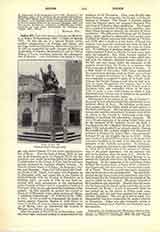

Julius III , POPE (GIAMMARIA CIOCCHI DEL MONTE), b. at Rome, September 10, 1487; d. there, March 23, 1555. He was the son of a famous Roman jurist, studied jurisprudence at Perugia and Siena, and theology under the Dominican, Ambrosius Catharinus. In 1512 he succeeded his uncle Antonio del Monte as Archbishop of Siponto (Manfredonia), and in 1520 as Bishop of Pavia, retaining, however, the administration of Siponto. Later he became vice-legate of Perugia, and under Clement VII was twice appointed prefect of Rome. After the Sack of Rome (1527) he was one of the hostages given by Clement VII to the Imperialists, and would have been killed by the imperial Landsknechte in the Campo di Fiori, had he not been secretly liberated by Cardinal Pompio Colonna. In 1534 he became legate of Bologna, the Romagna, Parma, and Piacenza. Pope Paul III created him Cardinal–Priest of SS. Vitalis, Gervasius, and Protasius on December 22, 1536, and raised him to the dignity of cardinal-bishop with the Diocese of Palestrina on October 5, 1543. As early as 1542 he had been entrusted with work preparatory to the convocation of the Council of Trent, and in a consistory held on February 6, 1545, he was appointed first president of the council. In this capacity he opened the council at Trent on December 13 with a short oration (cf. Ehses, “Concilium Tridentinum”, IV, Freiburg im Br., 1904, p. 516). At the council he represented the papal interests against Emperor Charles V, with whom he came in conflict on various occasions, especially when on March 26, 1547, he transferred the Council to Bologna (see Council of Trent).
After the death of Paul III on November 10, 1549, the forty-eight cardinals present in Rome entered the conclave on November 29. They were divided into three factions: the Imperials, the French, and the adherents of Farnese. The friends of Farnese united with the Imperial party and proposed Reginald Pole and Juan de Toledo as their candidates. The French party rejected both and, though in the minority, they were strong enough to prevent the election of either candidate. The adherents of Farnese and the French party finally reached a compromise and agreed upon Cardinal del Monte, who was duly elected on February 7, 1550, after a conclave of ten weeks, although the emperor had expressly excluded him from the list of candidates. The new pope took the name of Julius III. In fulfilment of promises made in the conclave, Julius restored Parma to Ottavio Farnese a few days after his accession. But, when Farnese applied to France for aid against the emperor, Julius allied himself with the emperor, declared Farnese deprived of his fief, and sent troops under the command of his nephew Giambattista del Monte to cooperate with Duke Gonzaga of Milan in the capture of Parma. In a Bull, dated November 13, 1550, Julius transferred the council from Bologna back to Trent, and ordered that its sessions be resumed on May 1, 1551, but he was compelled to suspend it again on April 15, 1552, because the French bishops would take no part in it, and, to escape his enemies, the emperor had to flee from Innsbruck. The success of the French arms in Northern Italy also compelled Julius on April 29, 1552, to make a truce with France, in which it was stipulated that Farnese was to remain in the peaceful possession of Parma for two years.
Discouraged at his failure as an ally of Charles V, the pope henceforth abstained from interfering in the political affairs of Italy. He withdrew to his luxurious palace, the Villa Giulia, which he had erected at the Porta del Popolo. Here he spent most of his time in ease and comfort, occasionally making a weak effort at reform in the Church by instituting a few committees of cardinals for reformatory purposes. He was a liberal supporter of the rising Jesuit Order, and at the instance of St. Ignatius issued the Bull of foundation for the Collegium Germanicum on August 31, 1552, and granted it an annual subsidy. During his pontificate the Catholic religion was temporarily restored in England by Queen Mary, who succeeded Edward VI on the English throne in 1553. Julius sent Cardinal Reginald Pole as legate to England with extensive faculties to be used at his discretion in the interests of the Catholic restoration. In February, 1555, an embassy was sent by the English Parliament to Julius III to inform him of its unreserved submission to the papal supremacy, but the embassy was still on its journey when the pope died. Shortly before his death Julius III sent Cardinal Morone to represent the Catholic interest at the Religious Peace of Augsburg. At the beginning of his pontificate Julius III had the earnest desire to bring about a reform in the Church and with this intent he reopened the Council of Trent. That the council was again suspended was due to the force of circumstances. His inactivity during the last three years of his pontificate may have been caused by the frequent and severe attacks of the gout to which he was subject. The great blemish in his pontificate was nepotism. Shortly after his accession he bestowed the purple on his unworthy favorite Innocenzo del Monte, a youth of seventeen whom he had picked up on the streets of Parma some years previously, and who had been adopted by the pope’s brother, Balduino. This act gave rise to some very disagreeable rumors concerning the pope’s relation to Innocenzo. Julius was also extremely lavish in bestowing ecclesiastical dignities and benefices upon his relatives.
MICHAEL OTT

